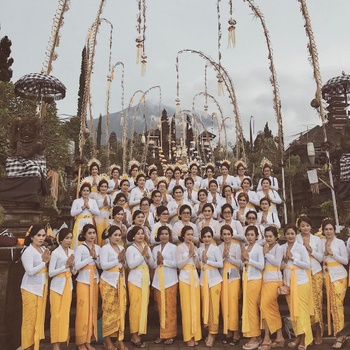
Balinese women in ceremonial kebaya likely in observance of cremation or Melasti. Kebaya is a traditional blouse-dress combination that originated from the court of the Majapahit Kingdom (today Indonesia), and is traditionally worn by Balinese women.
The Balinese kebaya is part of busana adat or customary dress, Balinese women are required to wear kebaya during Balinese Hindu rituals and ceremony in pura. White kebaya are favoured for Balinese religious rituals. Other than religious ceremony, contemporary Balinese women also often wear kebaya for their daily activities. Because most Balinese people are Hindus, the Balinese kebaya usually has shorter sleeves than Javanese kebaya.
All temple visitors, men included, are expected to wear a sarong and sash, these are provided at the temple entrance or you can bring your own.
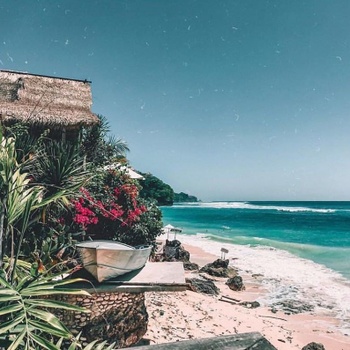
For decades, beaches around the Bukit had been well known by surfers and also nudists due to its location behind the cliffs with limited access.
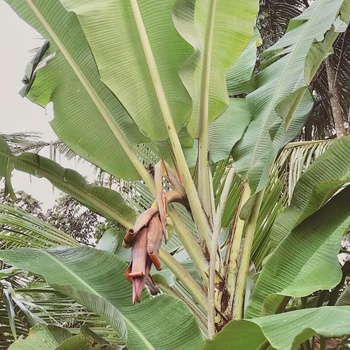
Known as 'The Island of the Gods' Bali is lush, tropical and abundant. Beautiful tropical flowers and bright green banana leaves grow wildly.
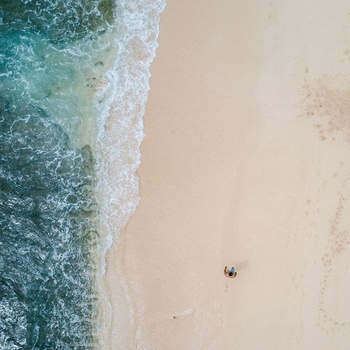
Not as other beaches which are located in the north of Uluwatu Temple, Nyang Nyang Beach is located in the southeast of Uluwatu Temple. It is a hidden beach suitable for surfing with large waves and also for sunbathing on the white rather course sandy beach.
From the parking area, you have to take the long tortuous stairway (more than 500 steep steps) to meet the quietest beach in Pecatu. No foods and drinks vendors at all so go prepared and enjoy.
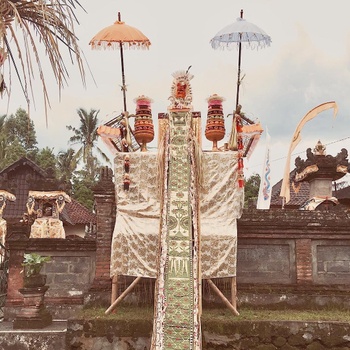
Selamat Hari Raya Kuningan!
Ending a ten day celebration in Bali when the angels of ancestors return to the heavens after visiting earth.Kuningan comes from kuning, the word for yellow. Offerings include yellow turmeric rice a symbol of gratitude to the Gods for life, joy, wealth, health and prosperity on earth and blessing the entire world.
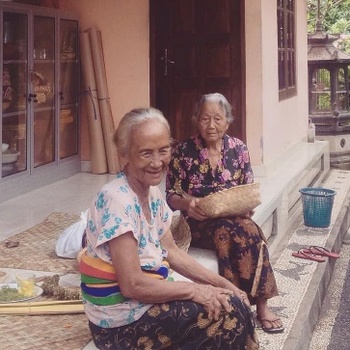
Ibu is the Indonesian word for mother. At home, twice daily Balinese women leave hand woven offerings for the gods at every entrance and temple with a beautiful and graceful ritual of incense and prayer.
Homemade Balinese sweets, a basket of bananas, a papaya, a coconut or fruit from the temple. And from time to time a very rare plate of rice with tofu is presented along with an apology for not having anything left to give.
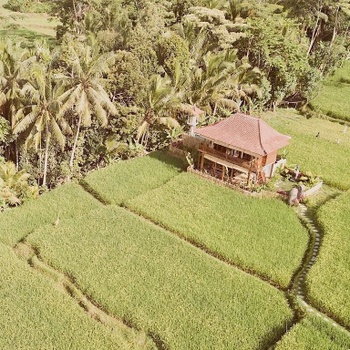
Rice is the life-blood of Bali. It permeates every aspect of Balinese culture, and has for at least two thousand years.
The current system of Subak Irrigation has been in use for at least 1000 years. This system is much more than a simple agriculture tradition, it is a tradition that is simultaneously spiritual and communal; deeply ingrained with Balinese culture. The very social structure within Bali is infused by this ancient tradition. You could even say that rice is Bali.
Ritual and spirituality are integral to the cycle of growing and harvesting rice. Ceremonies and offerings to Dewi Sri (the goddess of rice and fertility) are performed throughout the year. Many ceremonies are performed on the farm, others at water temples, (temples specifically dedicated to performing rituals honoring Dewi Sri so that she can bless their rice harvest). The upstream corner of every rice field is sacred. All of the offerings to Dewi Sri done on the farm are performed here.
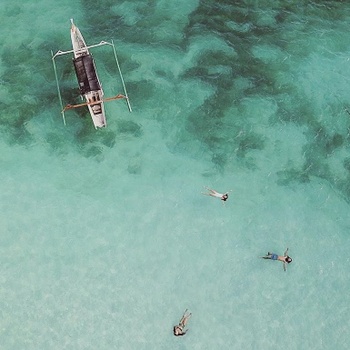
One of the smallest islands in the Indonesian archipelago, Bali is a small taste of paradise. Bukit Bali is surrounded by the turquoise waters of the Indian Ocean making it a must stay.
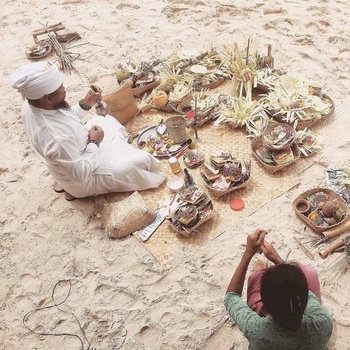
The Balinese believe that good spirits reside in the mountains and evils ones live in the sea or water and that people live between. Mountains are the highest and holiest of all places.
Houses are oriented towards the mountains and beds are positioned so head is closest to them. People on Bali sleep with their head pointed to sacred Mt. Agung. The volcanos on Bali run from east to west and instructions are given in terms of direction orientation to these mountains instead of left and right.
The rivers and coastal areas are the lowest and unholiest of places—where the demons dwell. Hills and other natural features are classified in term of their evaluation: the higher the holier.
One of the most striking things about Bali is the daily profusion of offerings. Offerings are important: they are to give pleasure to the gods (and the demons). Offerings for Durga and the demons always contain some pork or fish, onions, ginger and alcohol (palm wine or brem).
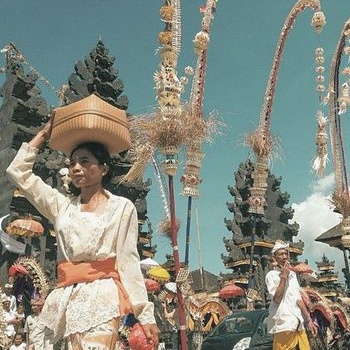
An entire island dripping in bamboo and coconut leaf penjors as symbols of the universe and everyone in fancy dress celebrating the victory of dharma over adharma!
Penjors are tall, decorated bamboo poles, whose curved upper ends, on which are attached elaborate offerings, perhaps in the form of a Cili, dangle graciously over the middle of the road. The gods on Mount Agung and visiting ancestors will see them clearly. They are erected outside temples and family houses during certain ceremonies, and always at Galungan, beside a temporary altar dressed with a lamak.
There are many theories about the symbolism of penjors. One is that the penjor represents and honours the serpent Anantaboga, whose name means food without end. The offering place at the bottom is his head. The decorations on his arching back are his scales and the wind chime is the tip of his tail.
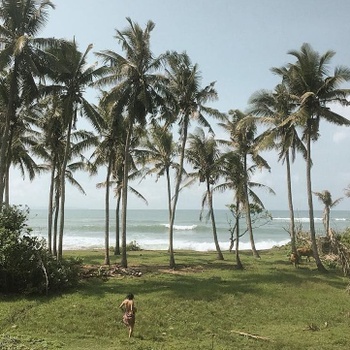
Palm-lined, white sand beaches rim gemstone green waters. This scene is the gateway to an Indonesian wave paradise – a land of almost unimaginably perfect reef breaks, seemingly around every second corner. Warm waters and plenty of swell Bali is a surfer's dream.
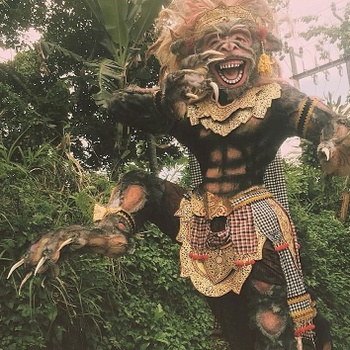
Ogoh-ogoh are statues built for the Ngrupuk parade, which takes place on the eve of Nyepi day in Bali, Indonesia. Ogoh-ogoh normally have form of mythological beings, mostly demons. As with many creative endeavours based on Balinese Hinduism, the creation of Ogoh-ogoh represents spiritual aims inspired by Hindu philosophy.
The main purpose of the making of Ogoh-ogoh is the purification of the natural environment of any spiritual pollutants emitted from the activities of living beings (especially humans). The forms of Ogoh-ogoh represent the Bhuta-Kala (Bhuta: eternal energy, Kala: eternal time), according to Hindu teachings. The imperceptible potentials of nature cannot be thoroughly explored by anyone. Philosophically, civilized men are required to manage the natural resources without damaging the environment itself.
Aside from being the symbol of Bhuta-Kala, Ogoh-ogoh is considered a symbol of modes of nature that form the malicious characters of living beings. Each village usually build one Ogoh-ogoh mainly built by each village's Seka Truna Truni (Balinese village's youth organization), but often some smaller ogoh-ogoh also built by groups of children around the village. Some artist also usually build one. After being paraded on a convoy around the town, finally it is burnt to ashes in a cemetery as a symbol of self-purification.
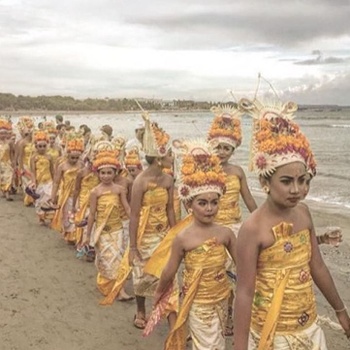
One of the precursors to Nyepi is the melasti ceremony, also known as ‘melis’. Whilst just as visually extravagant as a piodalan temple ceremony, melasti is of incredible importance to the annual (and sometimes more) rites of the Balinese Hindu. During this ceremony, lines and lines of local Hindus will journey to the sea or a holy spring for a special purification.
As the term purification suggests, the goal of melasti is to remove impurities, but unlike the melukat ceremony it isn’t the ‘self’ that is being purified, but rather of a village, its deities (through their earthly representations) and other external components.
During melasti, village communities (or banjar) travel together to their closest source of holy water, to some this may be a holy spring, to others this is the sea. It’s hard to miss, as lines of ladies carrying offerings on their heads (a procession called ‘Mapeed’), men carrying the pratima shrines on their shoulders and others holding up Balinese umbrellas take to the streets and walk from temple or village to the coast. Or you may see them piled into trucks, dressed in their kebaya, sarongs and udengs, umbrellas poking out the top. In either situation, the Balinese gamelan orchestra are always nearby, the clangs, bangs and clashes adding to the atmosphere.
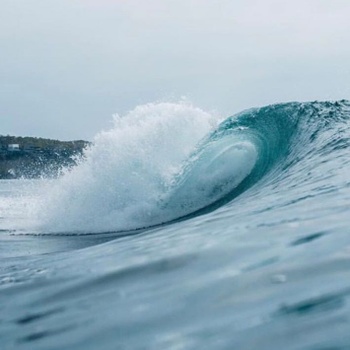
Bali is considered a mecca for warm water surfing and is a well-established surf destination on the world’s professional circuit.
Surfers who have experienced perfect waves all over the world claim that Bali surf’s power, speed, and consistency is comparable to almost anywhere. The island gets the full force of Southern Ocean swells traveling thousands of miles to break over shallow coral reefs.
Trade winds blow away from the land, giving shape and consistency to year-round swells, drawing thousands of Australians, Californians, Japanese and Brazilians each year to test themselves on the island’s famous tubular waves.